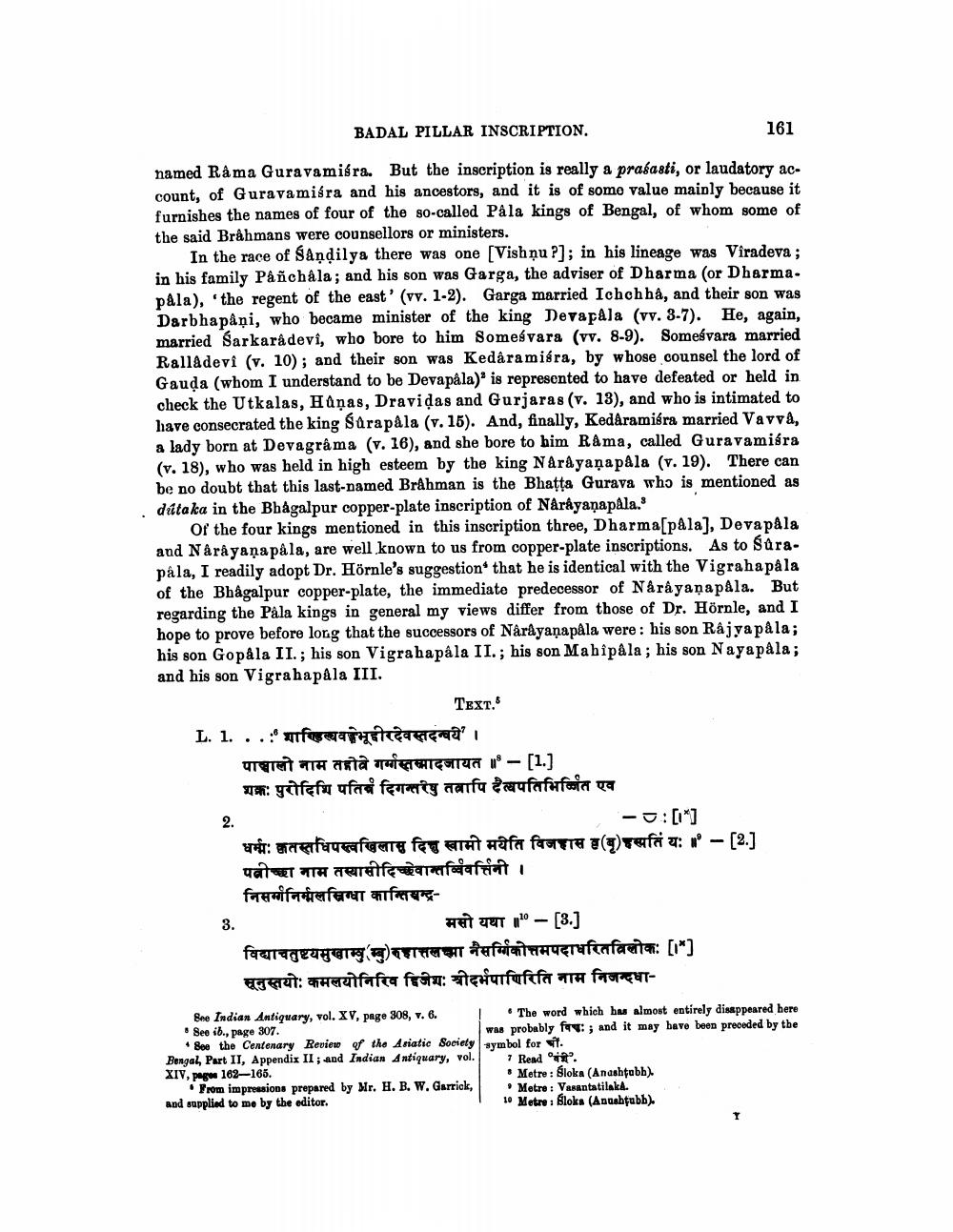________________
BADAL PILLAR INSCRIPTION.
161
named Rama Guravamiéra. But the inscription is really a prasasti, or laudatory account, of Guravamiśra and his ancestors, and it is of some value mainly because it furnishes the names of four of the so-called Påla kings of Bengal, of whom some of the said Brahmans were counsellors or ministers.
In the race of Sandilya there was one (Vishņu?]; in his lineage was Viradeva ; in his family Pañchâla; and his son was Garga, the adviser of Dharma (or Dharma. pala), the regent of the east' (vv. 1-2). Garga married Ichchhà, and their son was Darbha påņi, who became minister of the king Devapala (vv. 3-7). He, again, married Sarkara devî, who bore to him Someśvara (vv. 8-9). Someśvara married Ralladevi (v. 10); and their son was Kedåra miéra, by whose counsel the lord of Gauda (whom I understand to be Devapala)' is represented to have defeated or held in check the Utkalas, Haņas, Dravidas and Gurjaras (v. 13), and who is intimated to have consecrated the king Sarapala (v. 15). And, finally, Kedaramiśra married Vavva, a lady born at Devagrâma (v. 16), and she bore to him Rama, called Guravamiéra (v. 18), who was held in high esteem by the king Narayanapala (v. 19). There can be no doubt that this last-named Brâhman is the Bhatta Gurava who is mentioned as dittaka in the Bhagalpur copper-plate inscription of Narayanapala.
Of the four kings mentioned in this inscription three, Dharmapala), Deva pala and Narayaņa påla, are well known to us from copper-plate inscriptions. As to Sûrapala, I readily adopt Dr. Hörnle's suggestion that he is identical with the Vigrahapala of the Bhagalpur copper-plate, the immediate predecessor of Narayanapala. But regarding the Pala kings in general my views differ from those of Dr. Hörnle, and I hope to prove before long that the successors of Narayanapala were: his son Rajya påla; his son Gopåla II. ; his son Vigrahapala II.; his son Mahipala; his son Nayapala; and his son Vigrahapala III.
Text. L. 1. ...mor easca
urgreit Tia asta agregatea r -[1.] शक्रः पुरोदिशि पति दिगन्तरेषु तत्रापि दैत्वपतिभिनित एव
- : [] maritageafgang FET ATH Rafa f e trata a: -2.] पत्नीच्छा नाम तस्यासीदिच्छेवान्तर्विवर्तिनी । fagmilfasterfemet afatever
HET JET M10 — [3.] विद्याचतुष्टयमुखाम्खुम्बु)कहात्तलमा नैसर्गिकोत्तमपदाधरितविलोकः [*] सूनुस्तयोः कमलयोनिरिव विजयः श्रीदर्भपाणिरिति नाम निजन्दधा
Bee Indian Antiquary, vol. XV, page 308, v. 6. See ib., page 307.
See the Centenary Review of the Asiatic Society Bengal, Part II, Appendix Il; and Indian Antiquary, vol. XIV, page 162–165.
From impressions prepared by Mr. H. B. W. Garrick, and supplied to me by the editor.
The word which has almost entirely disappeared here was probably few: ; and it may bave been preceded by the symbol for it.
* Read . • Metre : Sloka (Anashtabb)
Metre : Vasantatilaka. 10 Metre : Bloks (Anushtabb).




